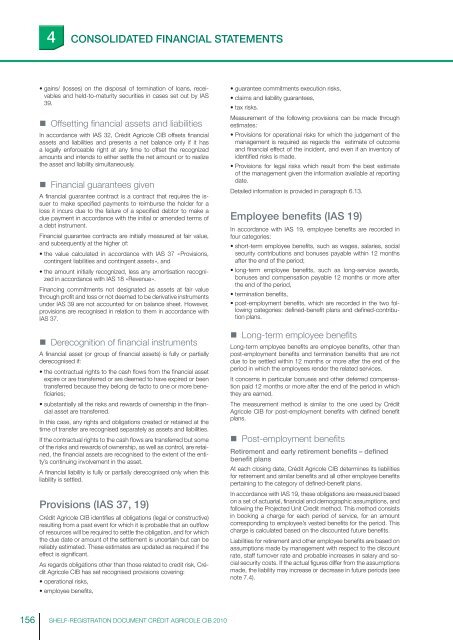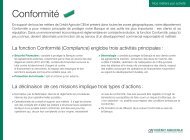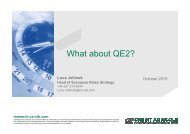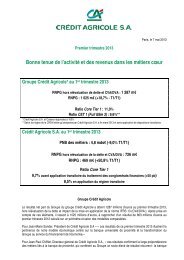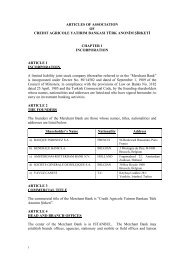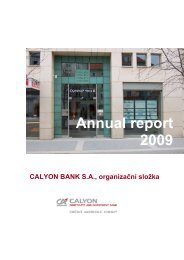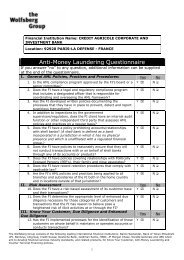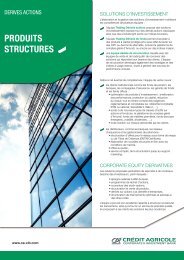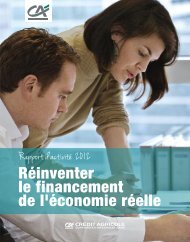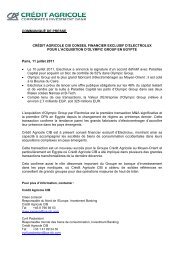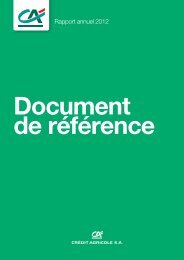ourexpertise - Crédit Agricole CIB
ourexpertise - Crédit Agricole CIB
ourexpertise - Crédit Agricole CIB
You also want an ePaper? Increase the reach of your titles
YUMPU automatically turns print PDFs into web optimized ePapers that Google loves.
4CONSOLIDATED FINANCIAL STATEMENTS• gains/ (losses) on the disposal of termination of loans, receivablesand held-to-maturity securities in cases set out by IAS39.• Offsetting fi nancial assets and liabilitiesIn accordance with IAS 32, <strong>Crédit</strong> <strong>Agricole</strong> <strong>CIB</strong> offsets fi nancialassets and liabilities and presents a net balance only if it hasa legally enforceable right at any time to offset the recognizedamounts and intends to either settle the net amount or to realizethe asset and liability simultaneously.• Financial guarantees givenA fi nancial guarantee contract is a contract that requires the issuerto make specifi ed payments to reimburse the holder for aloss it incurs due to the failure of a specifi ed debtor to make adue payment in accordance with the initial or amended terms ofa debt instrument.Financial guarantee contracts are initially measured at fair value,and subsequently at the higher of:• the value calculated in accordance with IAS 37 « Provisions,contingent liabilities and contingent assets », and• the amount initially recognized, less any amortisation recognizedin accordance with IAS 18 « Revenue ».Financing commitments not designated as assets at fair valuethrough profi t and loss or not deemed to be derivative instrumentsunder IAS 39 are not accounted for on balance sheet. However,provisions are recognised in relation to them in accordance withIAS 37.• Derecognition of fi nancial instrumentsA fi nancial asset (or group of fi nancial assets) is fully or partiallyderecognised if:• the contractual rights to the cash fl ows from the fi nancial assetexpire or are transferred or are deemed to have expired or beentransferred because they belong de facto to one or more beneficiaries;• substantially all the risks and rewards of ownership in the fi nancialasset are transferred.In this case, any rights and obligations created or retained at thetime of transfer are recognised separately as assets and liabilities.If the contractual rights to the cash fl ows are transferred but someof the risks and rewards of ownership, as well as control, are retained,the fi nancial assets are recognised to the extent of the entity’scontinuing involvement in the asset.A fi nancial liability is fully or partially derecognised only when thisliability is settled.Provisions (IAS 37, 19)<strong>Crédit</strong> <strong>Agricole</strong> <strong>CIB</strong> identifi es all obligations (legal or constructive)resulting from a past event for which it is probable that an outfl owof resources will be required to settle the obligation, and for whichthe due date or amount of the settlement is uncertain but can bereliably estimated. These estimates are updated as required if theeffect is signifi cant.As regards obligations other than those related to credit risk, <strong>Crédit</strong><strong>Agricole</strong> <strong>CIB</strong> has set recognised provisions covering:• operational risks,• employee benefi ts,• guarantee commitments execution risks,• claims and liability guarantees,• tax risks.Measurement of the following provisions can be made throughestimates:• Provisions for operational risks for which the judgement of themanagement is required as regards the estimate of outcomeand fi nancial effect of the incident, and even if an inventory ofidentifi ed risks is made.• Provisions for legal risks which result from the best estimateof the management given the information available at reportingdate.Detailed information is provided in paragraph 6.13.Employee benefits (IAS 19)In accordance with IAS 19, employee benefi ts are recorded infour categories:• short-term employee benefi ts, such as wages, salaries, socialsecurity contributions and bonuses payable within 12 monthsafter the end of the period;• long-term employee benefi ts, such as long-service awards,bonuses and compensation payable 12 months or more afterthe end of the period,• termination benefi ts,• post-employment benefi ts, which are recorded in the two followingcategories: defi ned-benefi t plans and defi ned-contributionplans.• Long-term employee benefi tsLong-term employee benefi ts are employee benefi ts, other thanpost-employment benefi ts and termination benefi ts that are notdue to be settled within 12 months or more after the end of theperiod in which the employees render the related services.It concerns in particular bonuses and other deferred compensationpaid 12 months or more after the end of the period in whichthey are earned.The measurement method is similar to the one used by <strong>Crédit</strong><strong>Agricole</strong> <strong>CIB</strong> for post-employment benefi ts with defi ned benefi tplans.• Post-employment benefi tsRetirement and early retirement benefits – definedbenefit plansAt each closing date, <strong>Crédit</strong> <strong>Agricole</strong> <strong>CIB</strong> determines its liabilitiesfor retirement and similar benefi ts and all other employee benefi tspertaining to the category of defi ned-benefi t plans.In accordance with IAS 19, these obligations are measured basedon a set of actuarial, fi nancial and demographic assumptions, andfollowing the Projected Unit Credit method. This method consistsin booking a charge for each period of service, for an amountcorresponding to employee’s vested benefi ts for the period. Thischarge is calculated based on the discounted future benefi ts.Liabilities for retirement and other employee benefi ts are based onassumptions made by management with respect to the discountrate, staff turnover rate and probable increases in salary and socialsecurity costs. If the actual fi gures differ from the assumptionsmade, the liability may increase or decrease in future periods (seenote 7.4).156SHELF-REGISTRATION DOCUMENT CRÉDIT AGRICOLE <strong>CIB</strong> 2010


